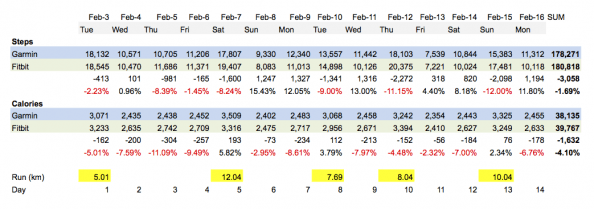 I’ve been testing for the last couple of weeks a Garmin Vivofit as a replacement of my Fitbit Force (see previous posts here and here). As a final part, here are some numbers from two weeks of continuous use of both devices.
I’ve been testing for the last couple of weeks a Garmin Vivofit as a replacement of my Fitbit Force (see previous posts here and here). As a final part, here are some numbers from two weeks of continuous use of both devices.
All in all, the differences vary from day to day, and fluctuate between one device capturing a bigger or a smaller number than other. The average difference seems small.
Garmin’s calorie data are actually a combination of the Vivofit data and ones from Garmin’s Forerunner 220 which I additionally use when I run. With that in mind, I tend to believe Garmin’s calorie more modest numbers better, also taking into account the end result of how quick my weight loss has been (steady but boringly slow :))
In regards to step data, I have to note something that might or might not make sense, or be correct. After the run I manually have been adding a fitness event in Fitbit’s interface, entering the data from the Forerunner, at which point Fitbit would recalculate the number of steps for the duration of the run. Interestingly, the calorie was barely affected each time. On the other hand, Fitbit would add 1-2000 steps to the daily count. I’m not sure if the recalculation is corrected or what Fitbit is intending with this feature.
Anyhow, the end result is what other similar (and more thorough) studies have shown, whereas fitness trackers from different companies will give varying counts. The point being though that it’s the overall trend that matters. Just choose and increase your mobility based on whatever number it tells you. The end result will be what you’d expect.
Tags: Fitbit, fitness, Garmin, quantified self, running, trackers, vivofit




